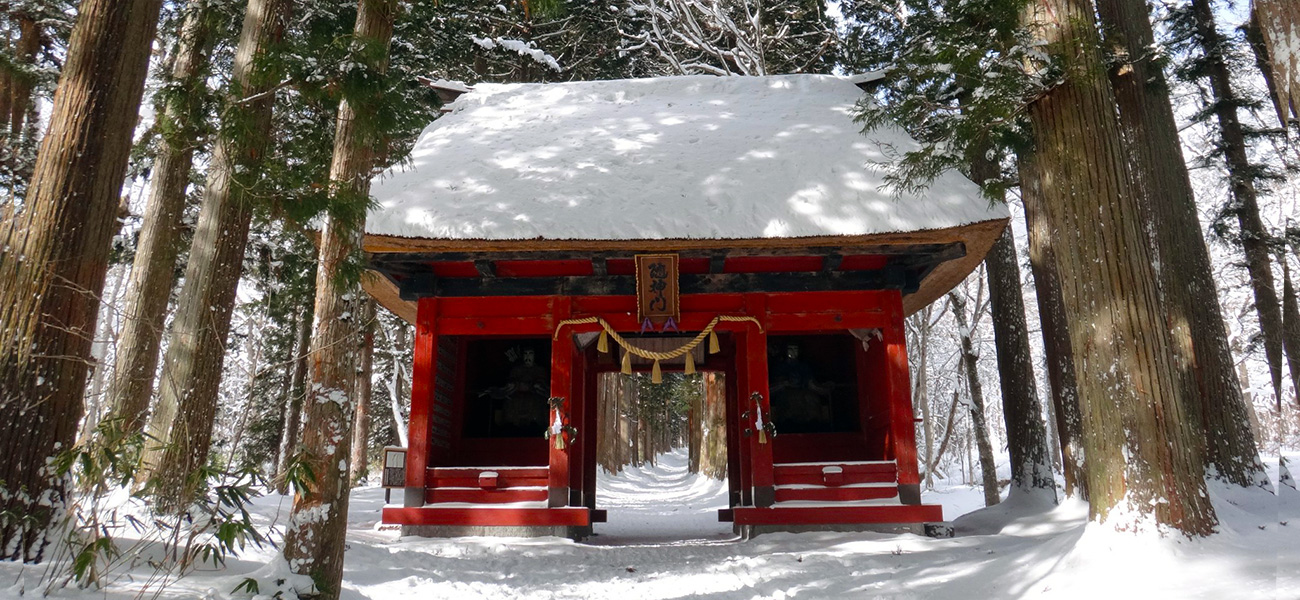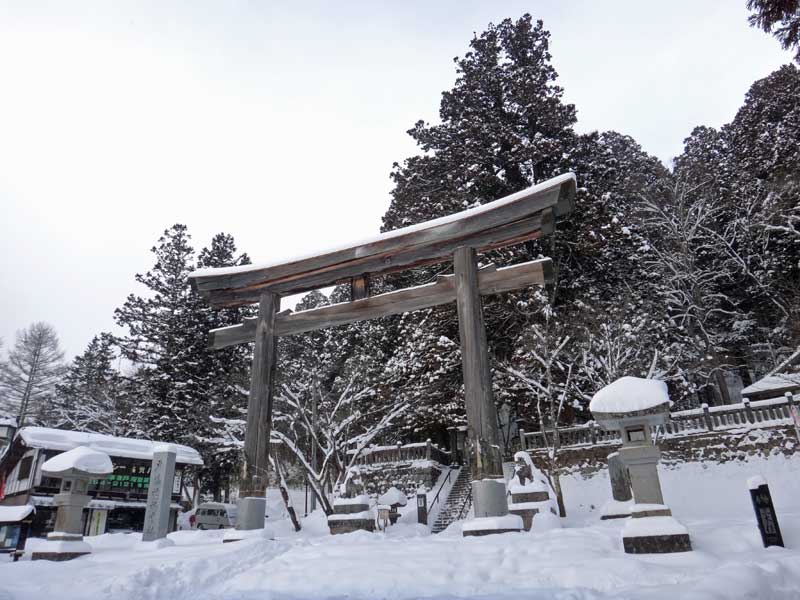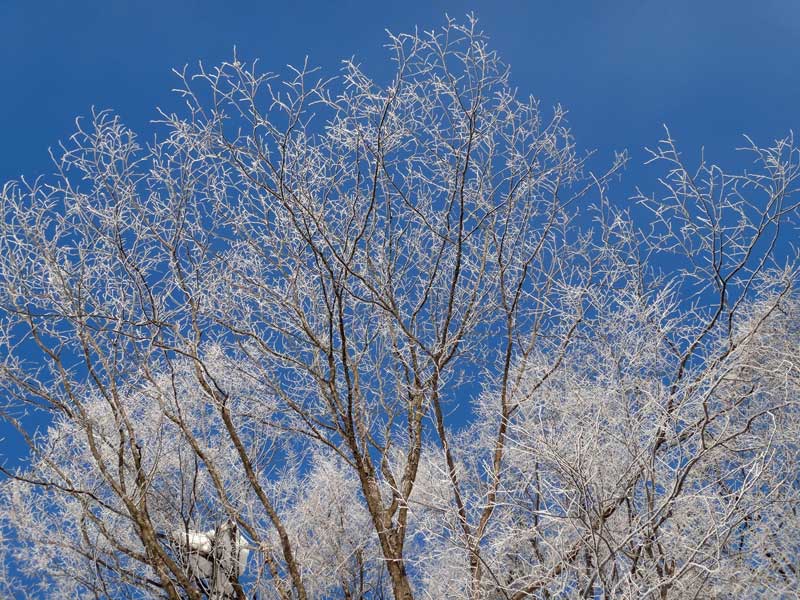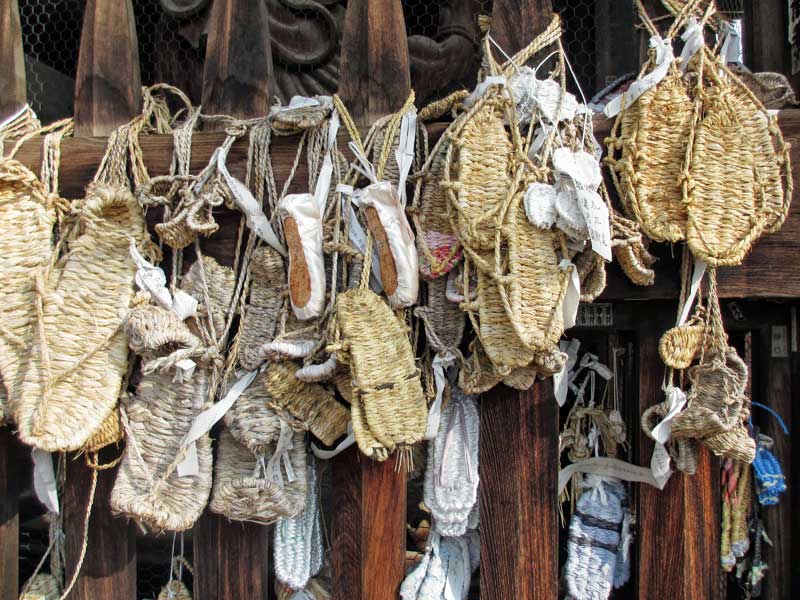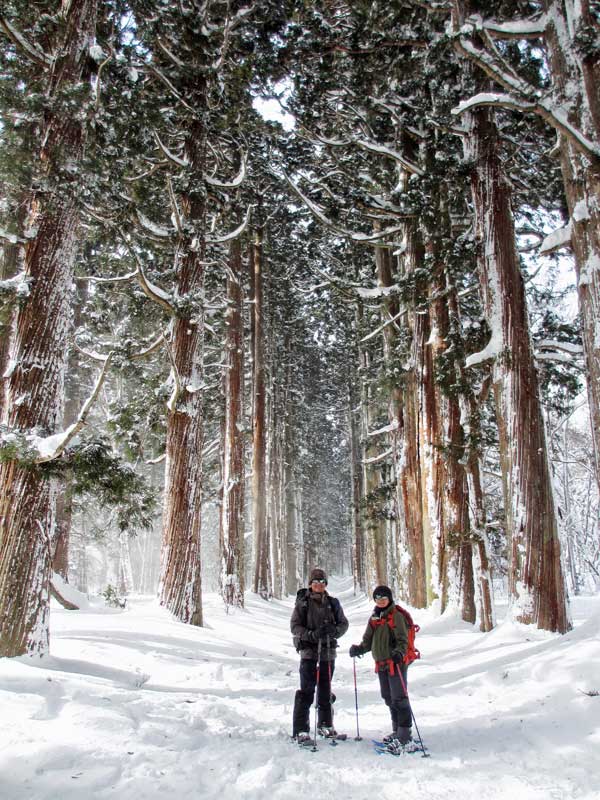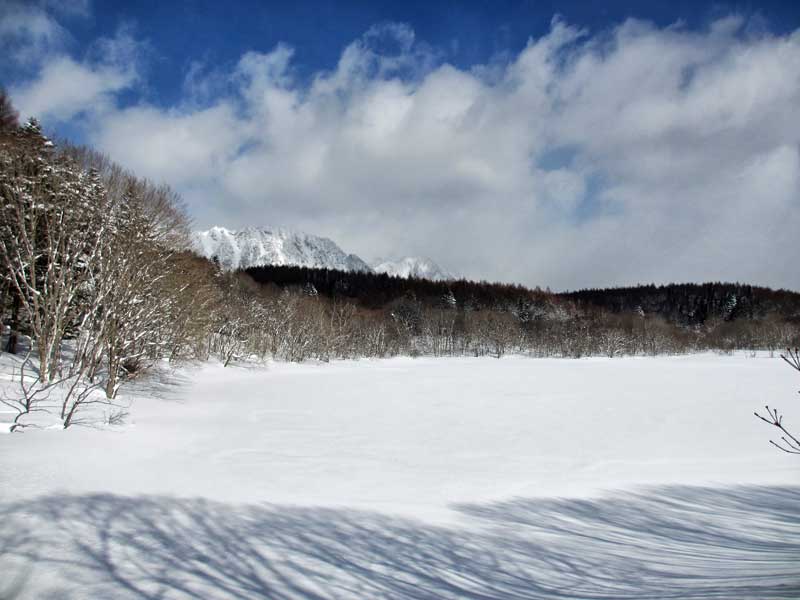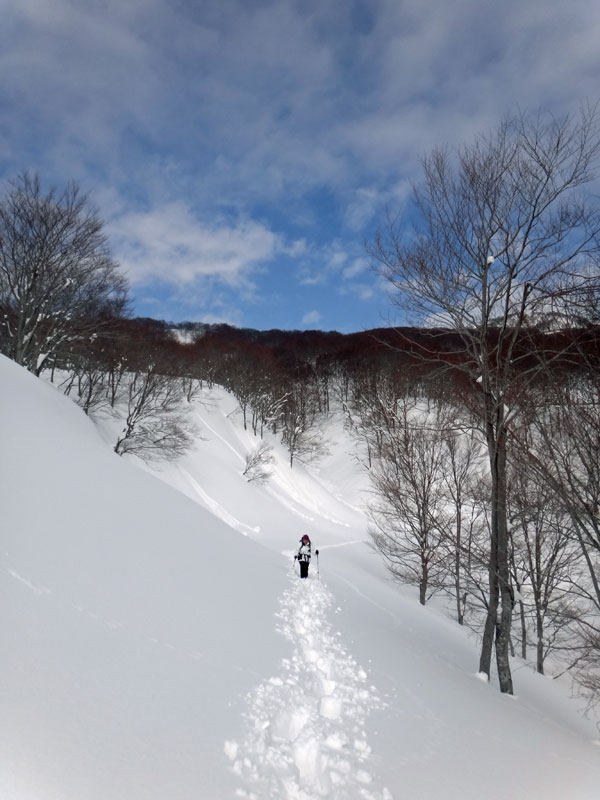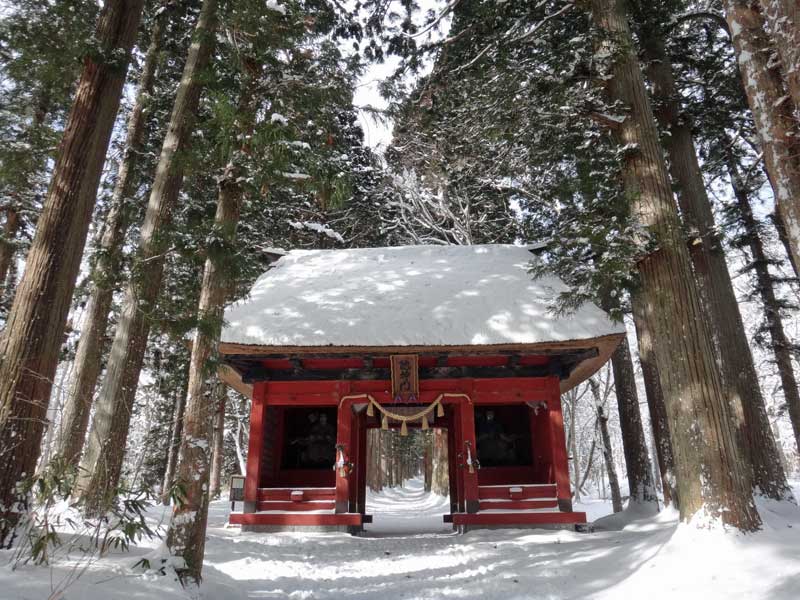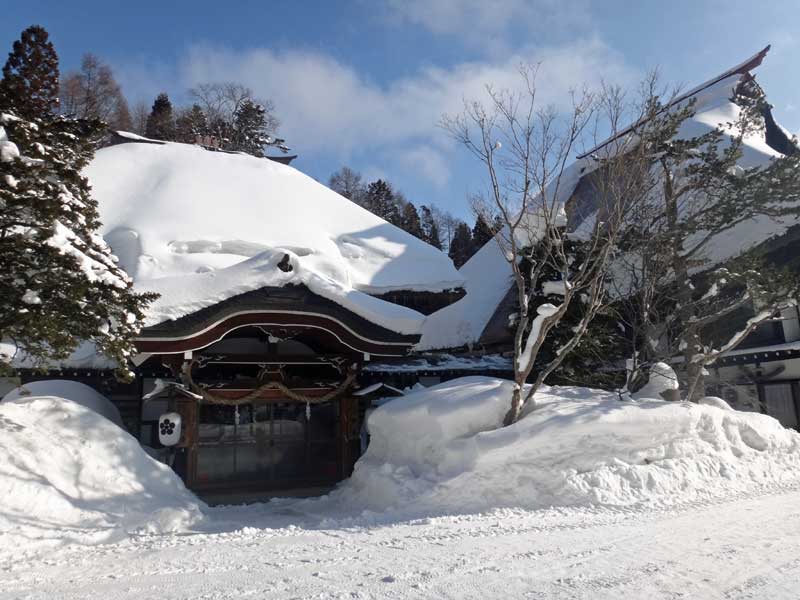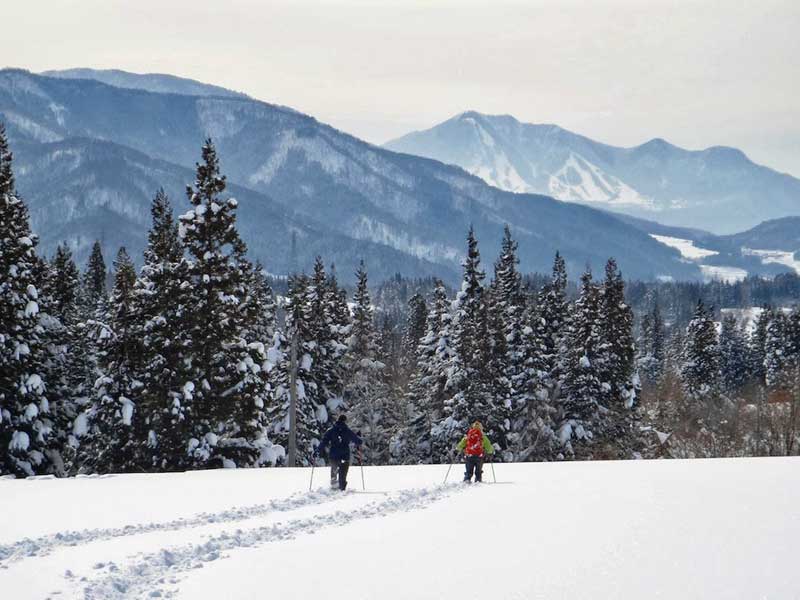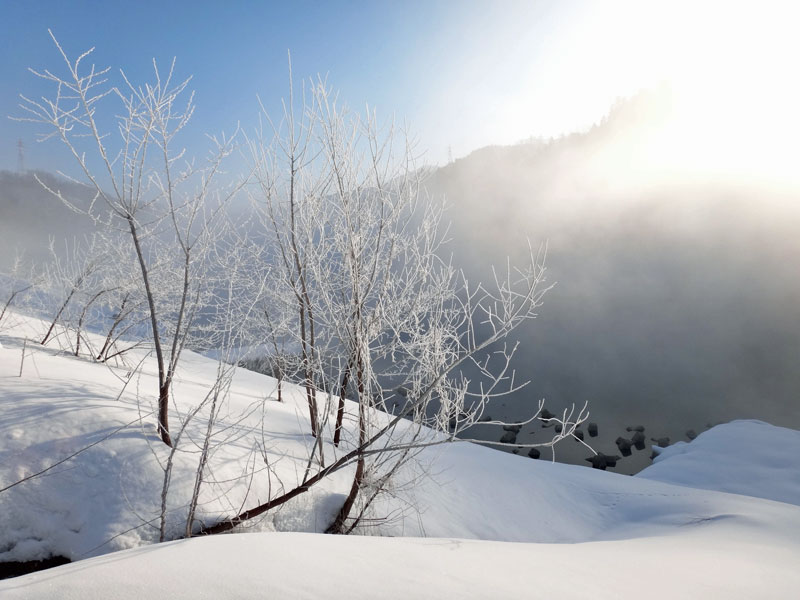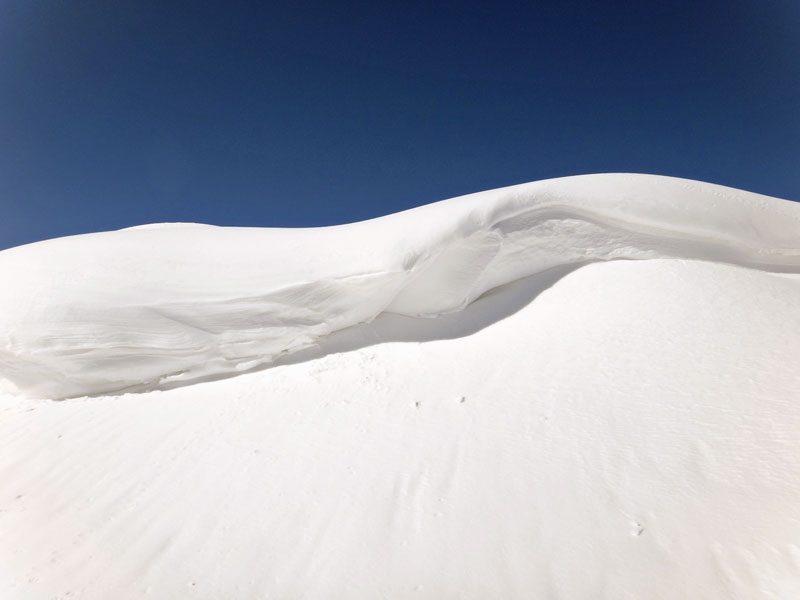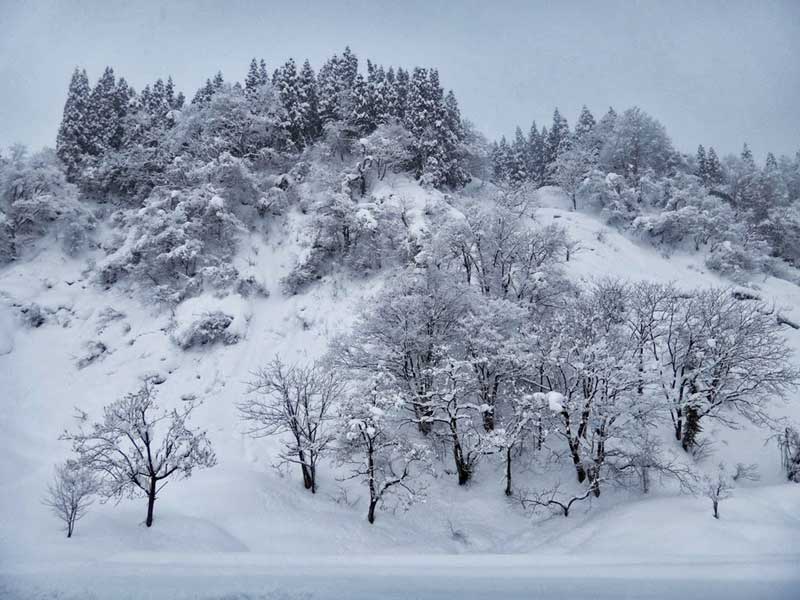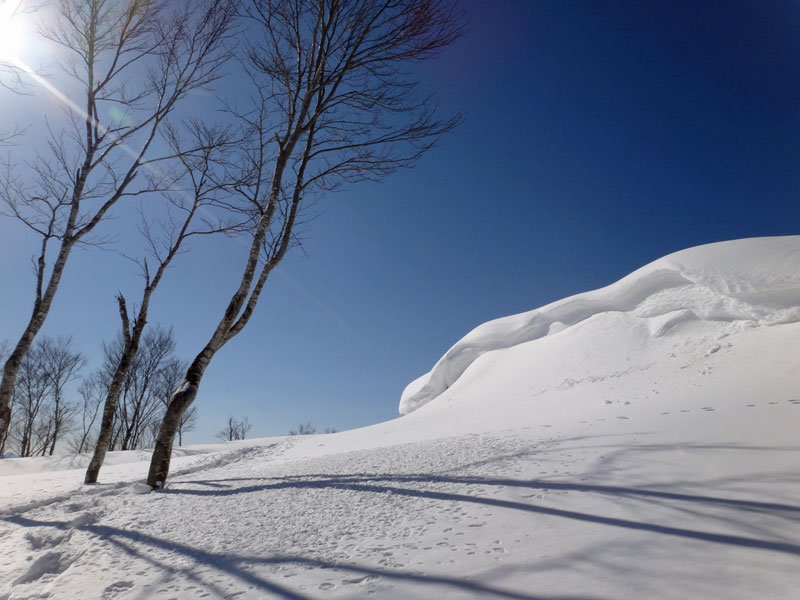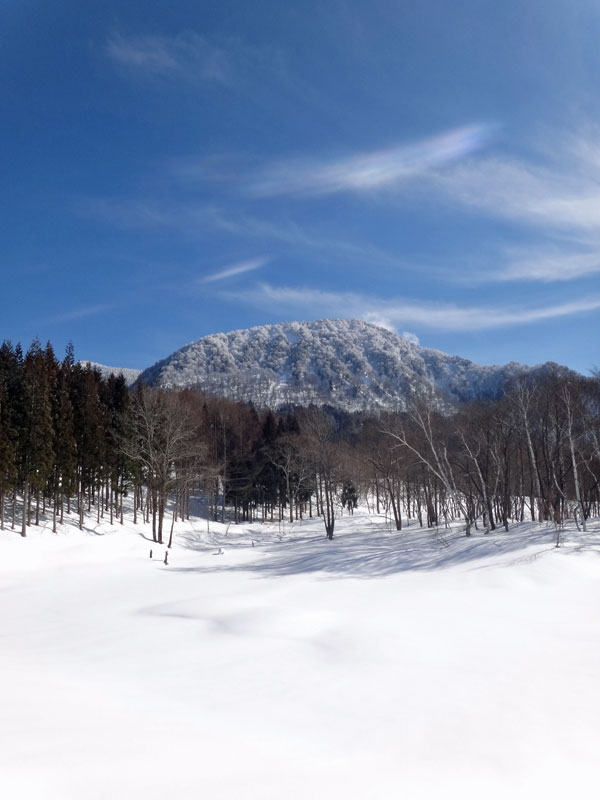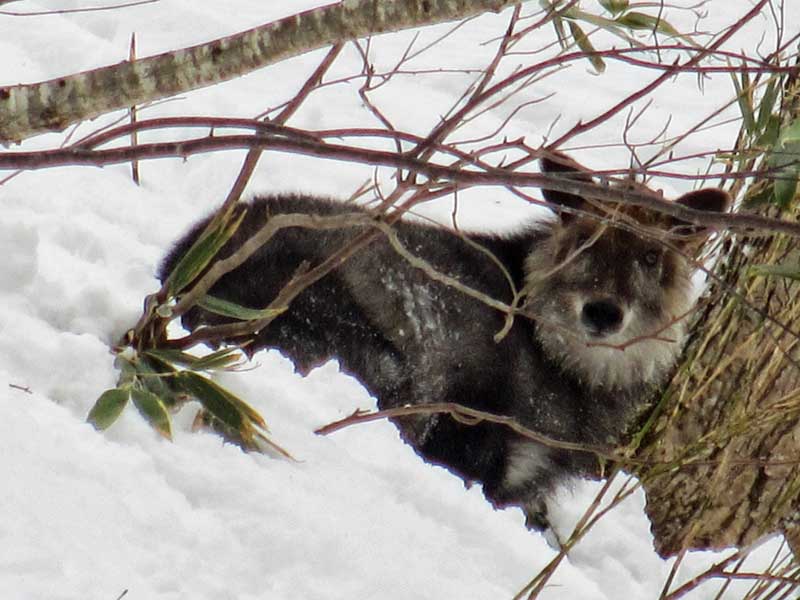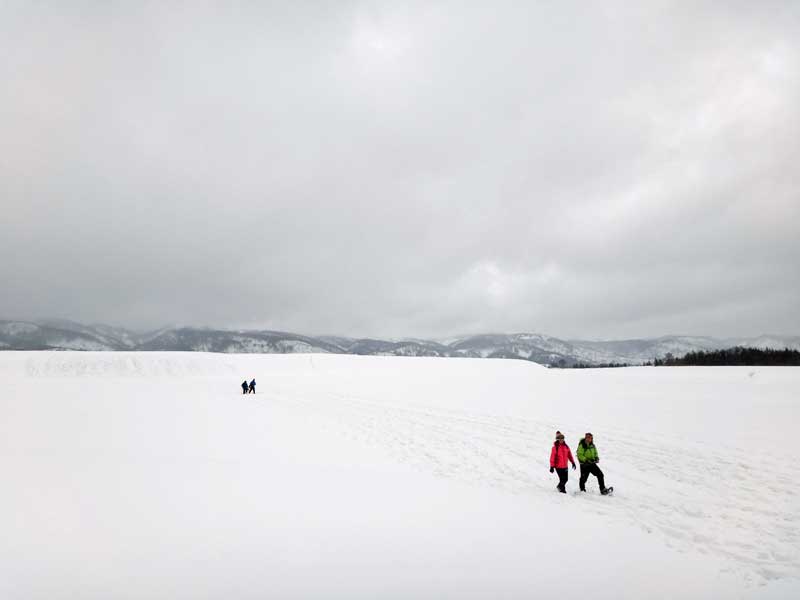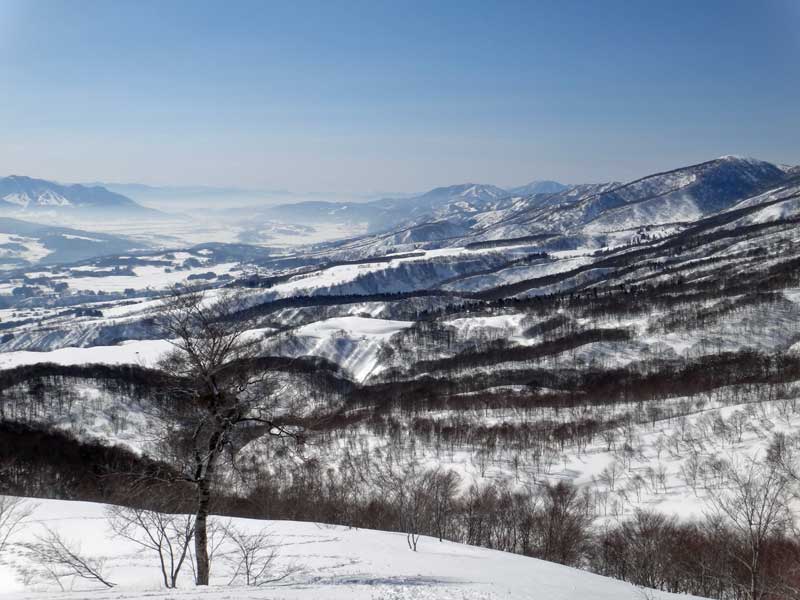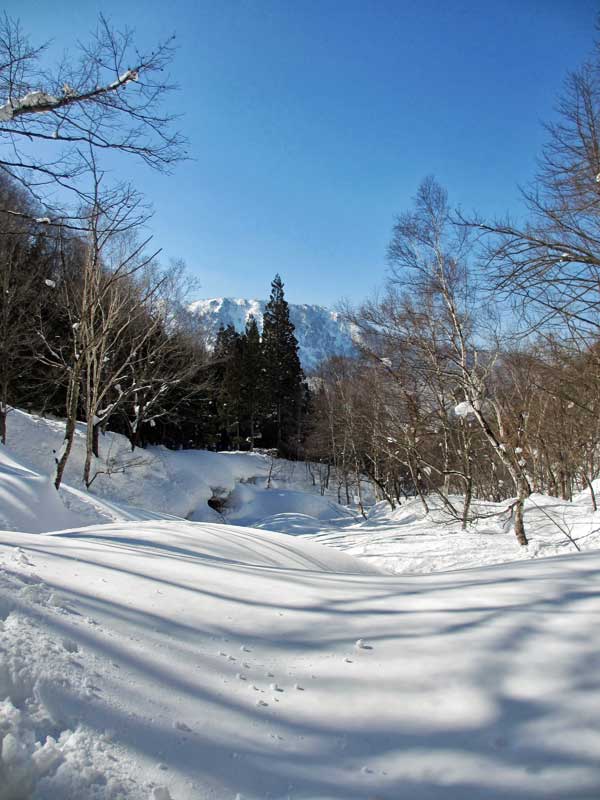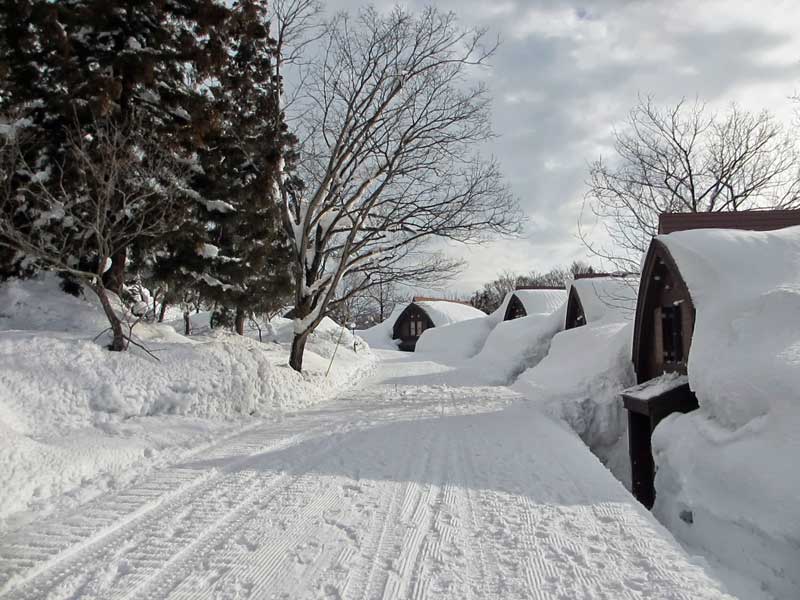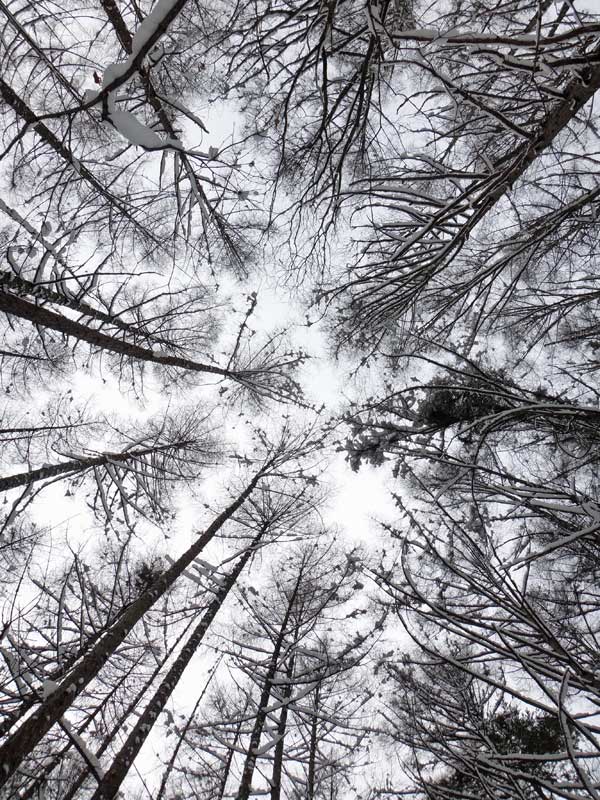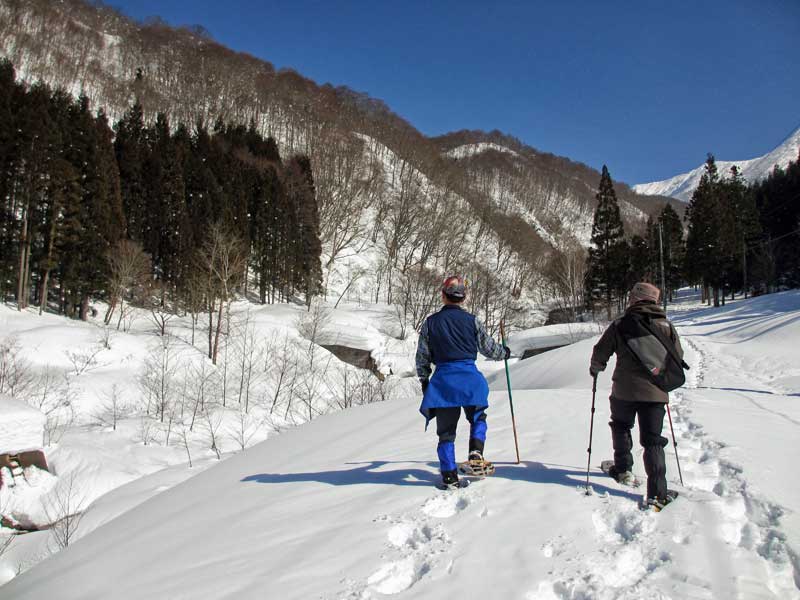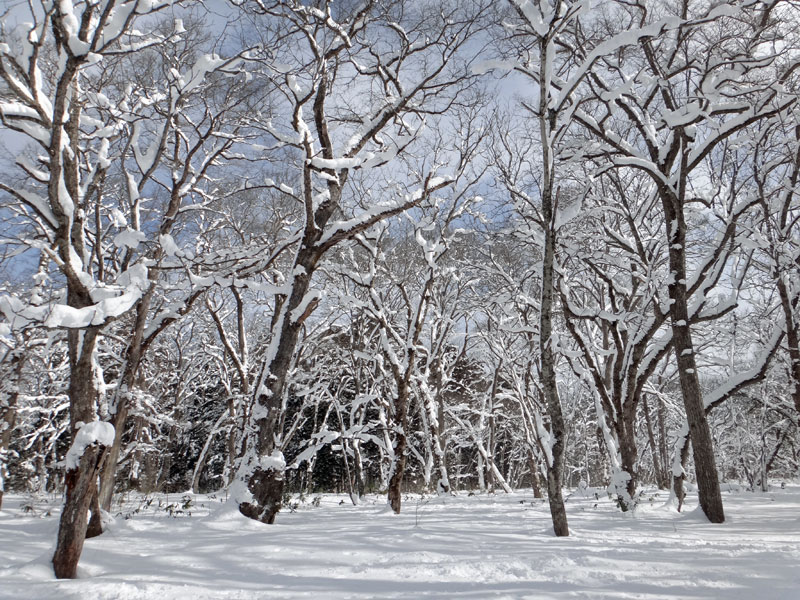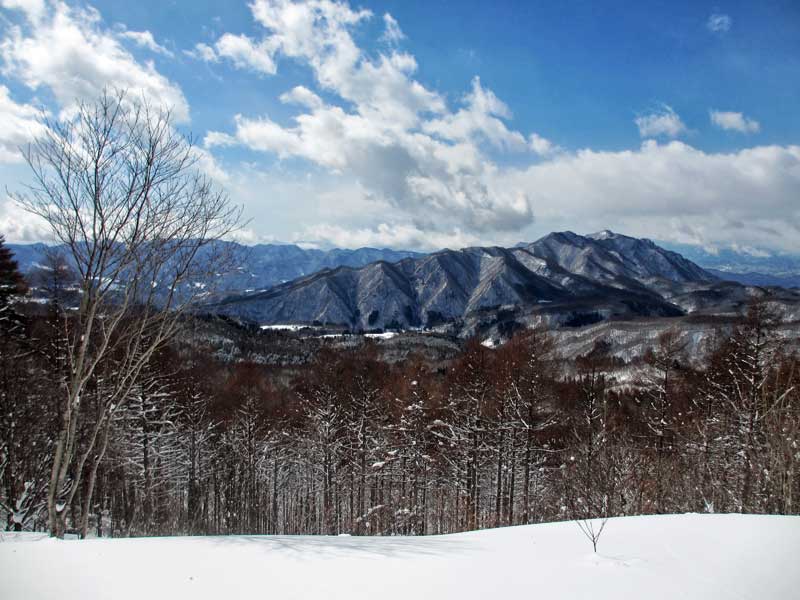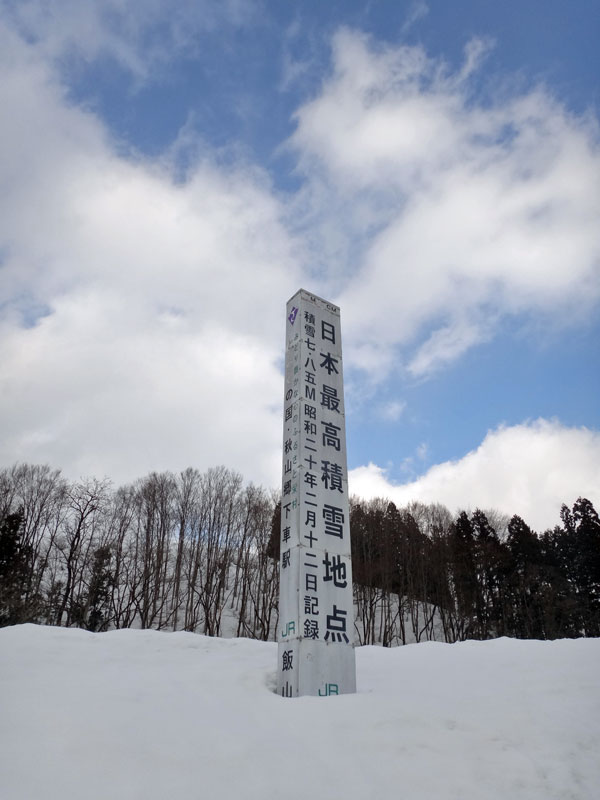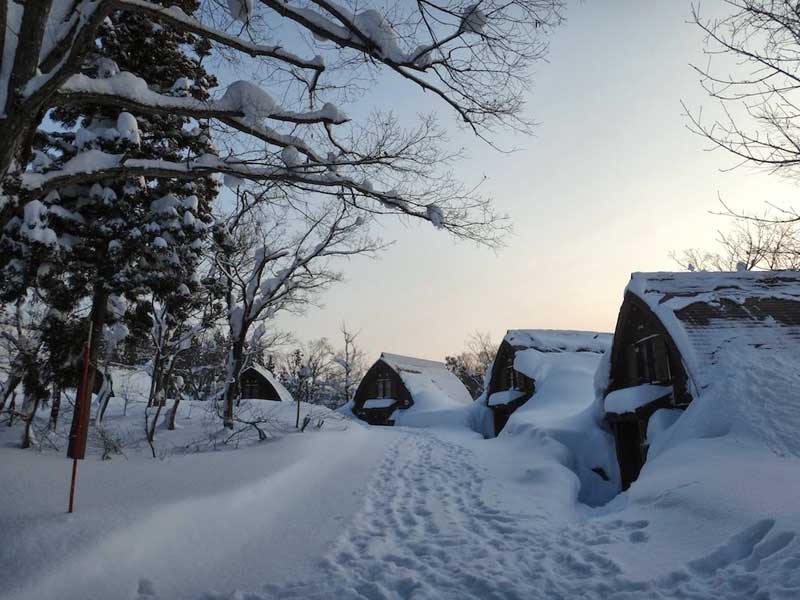A snowshoe tour through Japan’s famed Snow Country.
Guided snowshoeing in Japan’s central Alps region, where pristine powder snow is metres deep and the vistas vast; ethereal, secluded shrines; hardy and friendly locals; accommodation in charming inns, with top-class local cuisine and onsen hot spring baths.
January, February & March.
A 7-day, 6-night tour starting and finishing in Nagano. Tour accommodation is in hotels, Japanese inns and mountain cottages. Please read more on accommodation here. The maximum group size for this tour is 12 persons. We have no minimum size. If we accept a booking we guarantee to run the tour.
The Nagano Snow Country tour is a fully-guided snowshoeing tour in Japan’s snow country, a region that each year records some of the heaviest snow falls found anywhere on Earth. This tour provides an intimate experience of life in a winter wonderland that can only be accessed using snowshoes: we visit a spectacular Shinto shrine complex; stay in charming farming villages located in deep valleys; and cross spectacular, remote winter landscapes where the only other footprints we see will almost certainly be left by the local wildlife. A highlight is a night walk through a beech forest.
North-westerly winds bring snow in abundance to the Sea of Japan coast. The 3,000m (9,842ft) plus range of high mountains that form the Central Alps generates the greatest winter precipitation on their northerly slopes and valleys: the Snow Country. Snow falls so deeply that the underlying natural landscape is completely transformed; forests take on an ethereal appearance; and houses literally disappear under the white blanket.
Mountains and the snow are the motifs for this region, where the locals have developed a unique way of life dictated by their environment. The scale of the mountains and the volume of snow are sources of hard toil and munificence; both mountains and snow are barriers of immense scale but also sources of food, lumber and bountiful water that spills through the rice paddies from spring through to the autumn. The locals are a hardy people with a generosity and warmth of spirit that inspires. We find warm welcomes wherever we go and sumptuous meals with ingredients sourced from the surrounding region. Among the locals we meet on our travels is a bear hunter. We find him in one of the remotest villages in Japan, where we join him for an intimate insight into a traditional way of life that has all but disappeared.
Our accommodation includes Shinto pilgrims’ lodgings, wooden cottages buried in deep snow and Japanese inns. On most nights we have the added delight of onsen thermal hot spring baths.
Our walks each day are between one and five hours and are generally on the flat. Although tour participants do not need to be experienced winter walkers, snowshoeing does require a reasonably good level of fitness. Please note that how far we can walk and how much energy we expend depends greatly on snow conditions; fresh, softer snow is more energy-intensive to walk on than compacted, older snow.

Day 1 Nagano – Togakushi
Your Walk Japan Tour Leader meets the tour group at 12:30pm at Nagano Station. Please make sure to eat lunch beforehand. Here your Tour Leader will make an equipment check before we transfer by vehicle to our next destination, Togakushi. Togakushi is an ancient Shinto complex of five major shrines set on a 1,200m (3,937ft) high mountain plateau. After arrival we start our first trek, a short warm-up and an introduction to snowshoeing techniques, that circuits through the grounds of the shrine.
Our accommodation for the next two nights is a Nationally Registered Cultural Property, an impressive thatched-roof building and one of the shrine’s lodgings for pilgrims. The building is typical of the region’s traditional architecture, providing us with interesting and rustic but comfortable quarters for the evening. Everyone meets at 6:00pm in the lobby for a briefing before enjoying the first of many a sumptuous meal, a fusion of local and modern Japanese cuisine, throughout the tour.
Accommodation: Shukubo pilgrim lodging.
Meals: Dinner provided.
Total walking: 1.5km (0.9 miles).
Total elevation gain: 138m (453ft).
Day 2 Togakushi
After breakfast we set off again for a longer trek through the surrounding shrine complex. Most likely we will be the only people out on the pristine snow. The shrine has been a centre for esoteric Buddhism and yamabushi, mountain ascetics for centuries. Our trail takes us through impressive torii shrine gates, past giant cedar trees and through snow-silent forests to Lake Kagami-ike. The lake, though, is hidden under deep snow. Clear weather provides us with spectacular views to the Togakushi mountain range, which is worshipped by the locals as the source of life-sustaining water. Lunch is taken at a delightful local soba buckwheat restaurant run by a friendly husband and wife team.
We return via a major shrine building to our accommodation. We relax in a nearby onsen thermal hot spring before enjoying dinner together.
Accommodation: Shukubo pilgrim lodging.
Meals: Breakfast, lunch & dinner provided.
Total walking: 4.5km (2.8 miles).
Total elevation gain: 118m (390ft).
Day 3 Togakushi – Nabekura
Before breakfast, you are welcome to join the morning Shinto ritual conducted in our accommodation by the resident priest. Even today, farmers seek the advice of the priests, who make predictions for the following year’s weather. After breakfast, we depart for Nabekura. This area experiences the heaviest snowfall of anywhere in the area, reaching depths of three metres on the lowlands and more than six metres up in the mountains.
On arrival, we set off on a trek in the company of a local resident, who describes the traditional way of life in the snow country. We also use the traditional kanjiki snow shoes made from bamboo instead of our modern equipment.
Our route takes us through the environs of Karayama, a hamlet consisting of about a dozen houses with large thatched roofs typical of the snow country. In the winter, the snow can become so deep that some residents have to enter and leave their houses from the second floor.
After saying farewell to our local guide and checking into our accommodation, we visit the nearby onsen. We also enjoy dinner here. Before turning in for the night, however, we set out for a short night hike. Whether moonlit or not, the snow provides us with enough visibility to make our way through an almost ethereal landscape. The Walk Japan tour leader will provide some hot wine and drinking chocolate to fortify us en route.
Our accommodation tonight is in mountain cottages. Access paths hemmed by towering walls of snow lead to the cottages, which themselves almost disappear into the white landscape.
Accommodation: Mountain cottages.
Meals: Breakfast, lunch & dinner provided.
Total walking: 3km (1.9 miles).
Total elevation gain: 30m (95ft).
Day 4 Nabekura – Nozawa Onsen
We eat breakfast in our accommodation before starting our trek up to Mt. Hanatate-yama (1,069m/3,507ft). Today includes the only significant climb of the tour: depending on the snow conditions, a two to three hour ascent. On a clear day, our journey to the peak rewards us with spectacular 360-degree views across the winter scenery of the surrounding Nagano and Niigata Prefectures to the Sea of Japan coast and Sado Island.
We take with us a traditional bento box for lunch. Our picnic spot provides us with tremendous views over the valley from where we started our trek. Our return journey takes us through expansive fields; lush in summer with soba buckwheat, a staple of the area, but in winter a pristine snowy expanse.
A short taxi journey brings us to Nozawa Onsen, where we stay the night. Nozawa Onsen has been famous since the Edo Period (1603–1868) for the medicinal qualities of its onsen thermal hot springs. It is also famous for the quality of its powder snow and was one of the first places in Japan to introduce skiing. Many Japanese Winter Olympians, including Gold Medal winners, hail from Nozawa Onsen.
We spend some time exploring this delightful small onsen and ski resort village, walking quaint winding narrow streets surrounded by steam billowing from the many onsen thermal springs; some of the hottest found in Japan. Our accommodation for the night is one of the many delightful Japanese inns in the town.
Accommodation: Traditional Japanese inn with onsen hot spring baths.
Meals: Breakfast, lunch & dinner provided.
Total walking: 6.5km (4 miles).
Total elevation gain: 550m (1,804ft).
Day 5 Nozawa Onsen – Akiyamago
Today we travel deeper into the snow country. After a relaxing morning we catch one of only a handful of local trains that run each day along the line that follows the course of the Chikuma River. A 7.85m (25ft 9in) pole in front of Morimiya-no-hara Station, where we finish our 45-minute train journey, marks the spot where the deepest snow ever in Japan was recorded. From here we travel through a long, narrow and deep valley dotted with hamlets to Koakasawa, a charming hamlet and one of the remotest settlements in the whole of Japan. Heavy snows of winter would frequently isolate Koakasawa; if persistent enough, famines would set in amongst the inhabitants. Until the advent of modern rice-growing techniques, the locals could only grow soba buckwheat and millet as staple crops using simple slash-and-burn farming methods.
We visit the house of one of the local characters of the hamlet, a bear hunter. He describes to us the challenges of life in the area and hunting. We also join him on a snowshoe trek up to the partially frozen Oze-taki waterfalls. On the way, our companion describes the wildlife of the area, and how to track and hunt in the traditional fashion.
Our nearby accommodation for the night is a lodge with onsen. Dinner includes homemade dishes made from local ingredients from the surrounding fields, mountains and rivers.
Accommodation: Lodge with onsen hot spring baths.
Meals: Breakfast, lunch & dinner provided.
Total walking: 2km (1.2 miles).
Total elevation gain: 90m (295ft).
Day 6 Akiyamago - Nagano
On a clear day, Mt. Torikabuto-yama (2,037m/6,683ft) provides a dramatic backdrop to our morning walk. Once again, we are most likely to be the only trekkers in the area. There is, though, a good probability that we will see the tracks of the elusive kamoshika, Japanese native deer, and, with luck, perhaps spy one or more of them. The duration and destination of our walk will depend on snow conditions and the weather.
Lunch and a dip in the onsen at our accommodation before leaving Akiyamago to catch a train back to Nagano and our hotel, which is adjacent to the station. Our final dinner together is at a lively izakaya restaurant, a popular destination for many Japanese. The large and varied menu is sure to cater to everyone's tastes.
Accommodation: Western-style hotel.
Meals: Breakfast, lunch & dinner provided.
Total walking: 3-4 km (1.9-2.5 miles).
Total elevation gain: 176m (578ft).
Day 7 Nagano
After breakfast, we shed our snowshoes for a walk through town to Zenko-ji temple, which dates back to the seventh century, making it one of the oldest in Japan. It is also one of the most popular and has been a major site of pilgrimage since its founding. After our visit, we return to Nagano Station, where the tour finishes at approximately 11am. Your Walk Japan tour leader will assist you in purchasing your train ticket, which is not included in the tour, to your next destination.
Accommodation: N/A.
Meals: Breakfast provided.
Total walking: 4km (2.5 miles).
Total elevation gain: N/A.
This itinerary is subject to change.
Access to the tour's start at Nagano Station is most easily achieved from one of Tokyo's International Airports, Narita or Haneda.
-----
FROM TOKYO’S NARITA AIRPORT (NRT)
Take the JR Narita Express (NEX) train for Tokyo Station. Transfer here to the Hokuriku Shinkasen bound for Nagano. The journey takes about three hours.
-----
FROM TOKYO'S HANEDA AIRPORT (HND)
Take the Tokyo Monorail to Hamamatsucho Station for transfer to the JR Yamanote Line to Tokyo Station. From here, board the Hokuriku Shinkasen bound for Nagano.
The pre-tour pack includes detailed instructions, including a map, for travel to the accommodation at the start of the tour.
Tour participants are advised not to book themselves out on an early morning flight at the end of the tour, as the journey from Nagano to either of Tokyo's international airports takes approximately 3 hours.

